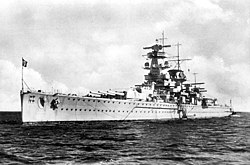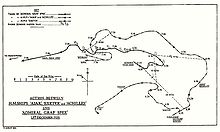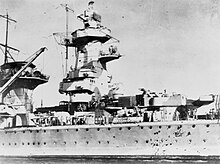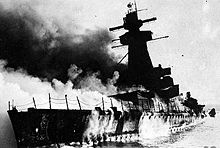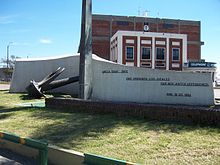Admiral Graf Spee
|
||||||||||||||||||||||
|
||||||||||||||||||||||
|
||||||||||||||||||||||
|
||||||||||||||||||||||
The Admiral Graf Spee was a battleship of Germany class , that of the German Navy during the Spanish Civil War and the beginning of World War II was used.
The only use of the ship in World War II was a pirate voyage in the South Atlantic as part of the trade war , in which nine merchant ships with 50,000 GRT were sunk without any loss of life. Off Uruguay , the Spee was damaged on December 13, 1939 in a battle against three British cruisers. The ship called at Montevideo to restore its full seaworthiness. Meanwhile, British warships blocked the mouth of the Río de la Plata . The government of Uruguay insisted that the ship leave within 72 hours, which meant that repairs were not possible. Since commander Hans Langsdorff believed himself to be in a hopeless situation - partly due to false information - and regarded an attempt to break through as without a chance, he had the ship sunk by his own crew in the Río de la Plata off Montevideo on December 17, 1939. Three days later - on December 20, 1939 - he took his own life by shooting himself in Buenos Aires.
history
Construction and first years of use

As a planned replacement for the old battleship Braunschweig was Admiral Graf Spee in the October 1, 1932 the Navy shipyard in Wilhelmshaven placed on Kiel . After 21 months of construction, she was launched on June 30, 1934, and was commissioned by the Navy on January 6, 1936. The ship was named in honor of Vice Admiral Maximilian von Spee , who commanded the German East Asia Squadron at the beginning of the First World War .
The first in command was Captain Conrad Patzig . In 1936 and 1937, the Admiral Graf Spee was the naval flagship of the Navy. In February 1937, during the Spanish Civil War , the Admiral Graf Spee shelled the city during the Battle of Malaga . With naval forces from Great Britain, Italy and France, the Admiral Graf Spee also participated in the international naval blockade to enforce an arms embargo against Spain, with the Navy being assigned a coastal area in the Mediterranean between Almería and Valencia .
Also in 1937 she took part in the international naval parade in front of Spithead on the occasion of the coronation of King George VI. from Great Britain.
The call sign used for optical signal traffic was GS (Gustav Sophie). At the beginning of 1938 the Admiral Graf Spee was equipped with the ship radar FuMG 38 Seetakt , making it the first ship of the German Navy to have a radar device. The sea cycle radar worked on a wavelength of 82 cm and was able to locate ship targets at a distance of 25 km.
On October 1, 1938, Hans Langsdorff became her third in command and led the ship to “bring the Memelland home ” in March 1939 to the Baltic Sea.
Trade war
The voyage of the Admiral Graf Spee under the command of Captain Hans Langsdorff began before the outbreak of the Second World War, as the ship had already left Wilhelmshaven on the evening of August 21, 1939 to be in waiting position in the South Atlantic .
On September 1, 1939, the Admiral Graf Spee met for the first time on the open sea with the Altmark fleet supply ship to replenish diesel. The trade war by the Admiral Graf Spee began on September 26; On this day, Captain Langsdorff received the order to attack allied merchant ships. In the period from September 30th to December 7th, the ship was able to sink a total of nine British merchant ships with a total of 50,089 gross register tons in the Atlantic and Indian Ocean , with not a single death. Before Langsdorff sank the angry ships, he gave the crews sufficient time to leave their ships in accordance with the award regulations . The shipwrecked were to be brought to Germany as prisoners of war. For this purpose, 303 British seamen were transferred to the supply ship Altmark , while the officers remained on the Admiral Graf Spee .
The Clement (5051 GRT) of the Booth-Steamship Co. from Liverpool was on its way from New York to Bahia with a load of 500 t of mixed cargo and 500 t of paraffin oil when she was at 9 ° 45 on September 30, 1939 ′ S , 34 ° 4 ′ W was sunk by artillery. The ship's crew reached the nearby Brazilian coast in the lifeboats . It was through this sinking that the British Admiralty was first informed of the presence of a German ironclad in the Atlantic.
The Newton Beach (4651 GRT) of Tyneside Lines from Newcastle with 7000 tons of maize was on its way from Cape Town to the UK when she on 5 October 1939 on the position 9 ° 35 ' S , 6 ° 30' W applied and on 8 October 1939 at the position 7 ° 45 ′ S , 3 ° 44 ′ W was sunk by explosion. Before the sinking, the radio operator managed to send an RRR call alerting the British heavy cruiser Cumberland , which was standing nearby. However, there was no meeting. The crew was taken over by the Admiral Graf Spee .
The Ashlea (4222 GRT) of Cliffside Shipping Co. was from Newcastle with 7200 tonnes of raw sugar on the journey from Durban to Britain when she on the position on October 7, 1939 9 ° 52 ' S , 3 ° 28' W was sunk.
The Huntsman (8196 GRT) of the shipping company T. & J. Harrison from Liverpool was first raised on October 10, 1939 at position 8 ° 30 ′ S , 5 ° 15 ′ W and on October 17, 1939 at position 16 ° 11 ′ S , 17 ° 6 ′ W sunk by blasting. With a freight of 10,000 tn.l. Tea, leather, hides and carpets on the journey from Calcutta to London. The crew was taken over by the Admiral Graf Spee .

The Trevanion (5291 GRT) of the shipping company Hain Steamship Co. of London was with 8835 tonnes zinc ore on the trip from Port Pirie to the UK when she on 22 October 1939 on the position 19 ° 40 ' S , 4 ° 20' O sunk has been. The radio operator succeeded in dropping an RRR message, the consequence of which was a large-scale search operation by the Commander in Chief South Atlantic , which was unsuccessful with regard to Admiral Graf Spee , but which resulted in the capture of five German merchant ships.
The Africa Shell (706 GRT), a British motor tanker for a shipping company in London, was on an empty voyage from Juelimare to Lourenço Marques (today: Maputo ) when it was blown up on November 15 in the Mozambique Strait near Cape Zavora was sunk. The entire 29-person crew reached Cape Zavora, 10 nm away , in the lifeboats .
The British turbine freighter Doric Star (10,086 GRT) of the Blue Star Line shipping company from London with a cargo of grain, wool and meat was on its way from Auckland to Great Britain when it was sunk on December 2, 1939 by explosions, shelling and torpedoing. The radio operator succeeded in sending an RRR message, which informed the British Admiralty of the new location of Admiral Graf Spee . The 64-man crew was taken over in full.
The refrigerated ship Tairoa (7983 GRT) of the shipping company Furness Lines from Southampton was on the voyage from Melbourne to Great Britain with 12,000 t of frozen meat when it was on December 3, 1939 in the South Atlantic at the position 20 ° 20 ′ S , 3 ° 5 ′ O was sunk. The radio operator also succeeded in sending an RRR message through which the position of Admiral Graf Spee became known.
The freighter Streonshalh (3895 GRT) of the shipping company Headlam & Son from Whitby was on its way from Buenos Aires to London with a load of 5900 tonnes of wheat when it was at 25 ° 0 ′ S , 27 ° 50 on December 7, 1939 ′ W was sunk.
On December 6 bunkerte the Admiral Graf Spee for the ninth and final time in the Altmark fuel. At dusk, a searchlight exercise against the Altmark was scheduled because the searchlights had not been used optimally when the Dutch steamer Holland stopped on November 14th . During this exercise, an unlit ship was discovered whose nationality could not be recognized and which was not attacked. As it turned out later, it was a Norwegian freighter that immediately radioed its observation to London via shortwave.
Battle in front of the Río de la Plata
Before returning home, Langsdorff wanted to go to the east coast of South America again in the hope of encountering a weakly secured British convoy. After the last oil replenishment at the Altmark supply ship , the ironclad headed there. On December 13, 1939, the Admiral Graf Spee met an enemy ship formation in front of the mouth of the Río de la Plata , consisting of the British heavy cruiser Exeter , the British light cruiser Ajax , flagship of the Commodore Henry Harwood , and the New Zealand light cruiser Achilles . The association was initially mistaken for a convoy accompanied by an auxiliary cruiser , then for a light cruiser accompanied by two destroyers . Only after the fire opened, when the battle could no longer be stopped due to the higher speed of the British ships, the ships were correctly identified. Instead of keeping the British ships at a distance and thus taking advantage of the range advantage of its larger guns, Langsdorff ordered them to drive at full speed. This brought the ship into the enemy’s fire area. Harwood split his formation to split the Graf Spee's firepower and fire on the ship from two sides. In the course of the sea battle, the Exeter was badly damaged (heavy artillery failed, 61 dead and 23 wounded) and put out of action. The two light cruisers, but also the Admiral Graf Spee , received damage. There were 36 dead and 60 wounded on the German ironclad. Langsdorff broke off the fight and ran into Montevideo to have repairs carried out and provisions, and then to start the journey home to Germany. As a result of the battle, the ship's food stores had been destroyed and the diesel oil cleaning system was damaged, so that the Spee only had cleaned oil for its diesel engines for one day.
In Montevideo
The British ambassador in Montevideo, Eugene Millington-Drake , negotiated with the Uruguayan government that the German ironclad should leave port within 72 hours - a time that was too short to carry out the urgent repairs but long enough to bring in British reinforcements. At the same time, the German envoy from Montevideo Otto Langmann telegraphed the following original passage to the Foreign Office in Berlin on December 16, 1939, 9:00 a.m.
"Superior heavy armed forces that were properly detected from the ship make it seem impossible for commanders to shake off contact holders and thus make a successful breakthrough home. A 14-day period would not change this, it would only make it easier to concentrate enemy forces. In accordance with the Naval Attaché, I consider internment ship to be the worst solution in any case. Blasting even in shallow La Plata waters with following internment is preferable to crew. Justification for ammunition exhaustion. […] There are unanimous reports from several shop stewards for the current pro-German attitude, not only for the President but also for the Foreign Minister. President expressed private hope that German submarines would soon appear for the purpose of blowing up (British) blocking of La Plata. "
According to British sources, this situation report was caused by deliberate misinformation of the British secret service MI6 , which the German side pretended to be a superior enemy task force on the high seas.
International maritime law stipulated that no warship was allowed to leave a port if a merchant ship on the opposing side had left it in the last 24 hours. Therefore the British ambassador made sure that a British merchant ship left the port every day, thus delaying the departure of the Admiral Graf Spee . The British reinforcements, which were already on their way, still needed time. Meanwhile, the Ajax and the Achilles monitored the La Plata Estuary together with the HMS Cumberland , which, coming from the Falkland Islands , joined Harwood's association to replace the Exeter , which had been released for repair .
The Admiral Graf Spee had suffered damage in the diesel oil cleaning system, which meant that cleaned fuel was only available for about a day. Other damage, such as the destroyed fresh water generator, required longer repairs. It was estimated that it would take seven days to repair the ship. The combat capability of the Admiral Graf Spee was fully preserved and a 15 cm gun that had failed due to enemy fire could be made fully operational again with on-board resources. The ship's stay was also used to bury the fallen soldiers, who were buried with military honors in the Montevideo North Cemetery. Under pressure from Great Britain, the Admiral Graf Spee was supposed to sail again after 72 hours. Before the ship went back to anchor, Langsdorff pointed out in a protest note to the Uruguayan government that, contrary to all statutes of neutrality, he was forced to sail with a ship that was not seaworthy, although in 1914 the British light cruiser Glasgow was after the sea battle the Falkland Islands had been granted over 30 days for repair work against a German squadron. Despite the help of German volunteers living in Uruguay and the crews of two German merchant ships in the port of Montevideo, the necessary repair work could not be carried out within the 72-hour period. The actual damage on the Graf Spee was unknown to the British .
At 1am on December 16, Langsdorff sent a radio report to the High Command of the Navy in Berlin, in which he suggested: "If it is possible, we will try to fight through to Buenos Aires, using the remaining ammunition." Buenos Aires , the capital of Argentina , lies on the south side of the Río de la Plata, where Langsdorff hoped to find better possibilities for the further fate of the ship. On the same day, the German naval command approved the proposal. The breakthrough to Argentina was not possible because it turned out that the Admiral Graf Spee would have remained tied to the shipping canal for a long time due to the shallow water depth of the La Plata estuary and would not have been able to maneuver militarily while the British warships were at sea would have had an easy target for their guns. Before leaving the port, Langsdorf released the officers of the hijacked ships who had been held captive on board the Spee.
Self-sinking of the ship
On December 17, 1939 at 6:15 p.m., the Admiral Graf Spee left the port of Montevideo. Thousands had gathered to watch the run out. After three nautical miles, Captain Langsdorff had anchor and explosives armed throughout the ship. The remaining crew of 40 men - the majority had already been secretly sent ashore in Montevideo - disembarked. At 7:52 p.m., the explosive charges detonated, the ship lay down on the floor of the La Plata estuary, only a few meters deep, and burned for three days. The crew of the Admiral Graf Spee now went to Buenos Aires . Due to various well-placed misinformation from the British, Captain Langsdorff had come to the conclusion that the HMS Ark Royal and another battle cruiser would be waiting for him outside the port .
Langsdorff shot himself in Buenos Aires . It was now December 20, 1939. Three days later he was buried in the German cemetery in Buenos Aires with a large participation of the population. The commanders and officers of the sunk and hijacked ships attended the funeral and laid a wreath. Later, many crew members of the Admiral Graf Spee settled in the small town of Villa General Belgrano , near the Argentine city of Córdoba , which still shows German traces in architecture and traditions.
In response to the self-sinking, Grand Admiral Erich Raeder issued the order two days after Langsdorff's suicide: "The German warship will fight with the full commitment of its crew to the last grenade, until it wins or goes down with a waving flag."
Telegram from the German envoy
In the reporting in the German Reich, the facts were twisted for propaganda purposes. As a result, on December 22, 1939, the following telegram from the German envoy from Montevideo Otto Langmann was sent to the Foreign Office in Berlin:
"Please urgently act on DNB ( German News Office ) to stop and deny false reports about bad behavior by British seafarers at the graves of the Graf Spee men. The untruth is evident here and only damages the credibility of all DNB reports without being of any use. The chivalry of the angry British seamen is sufficiently widespread in the (South) American press via United Press, recognizing the good behavior of the Spee crew towards them, so that the DNB's report of the dead is used against us from the outset as implausible, as it is has already happened in some leaves. The attitude of the South American public towards the dead of the Spee is so appreciative and compassionate that such false reports are ultimately devastating for Germany and drive the public here hopelessly into the arms of enemy propaganda. "
Altmark supply ship
The supply ship Altmark now tried to make its way home alone under the leadership of Captain Heinrich Dau . At first it dodged south, where the British least suspected the ship. A few weeks later, the tanker ventured north again and passed the equator, the North Atlantic and the Denmark Strait unmolested . In mid-February 1940 it reached neutral waters near Trondheim . Negotiations with the Norwegian Navy for the purpose of piloting and continuing travel within the three-mile zone proved difficult. On February 16, the Altmark was first sighted by British aircraft and later by British destroyers, accompanied by Norwegian torpedo boats. Despite the neutrality regulations, the destroyers came closer and tried to force the Altmark into the open sea. This then fled to the Jössingfjord . After dark, the British destroyers followed. A ramming attempt through the Altmark ended with it running aground. After the destroyer pulled alongside Cossack , British forces released 303 captured British sailors; seven German seafarers were killed.
Recovery attempts
The first thing that was lifted in 1997 was a 15 cm gun barrel, which is now in Montevideo in front of the Museo Naval . At the beginning of 2004 it was announced that the whole wreck would be born. Despite protests from the federal government , which saw the Federal Republic of Germany as the owner of the ironclad, the wreck began to be lifted from a depth of eight meters using a floating crane in February 2004 . This salvage operation was financed by private investors and the state of Uruguay , as the wreck increasingly endangered shipping. On February 25, 2004, the first larger piece was recovered. It was one of the two optical range finders, which with its armored rotating hood weighs 27 tons and was mounted on one of the two artillery control posts.
In February 2006, the 400 kg bronze eagle standing on a wreath of oak leaves with a swastika was recovered. The eagle is around two meters tall, has a wingspan of 2.8 meters and adorned the stern of the Admiral Graf Spee . In August 2006, the announcement by the private salvage company that it would sell the eagle against the will of the Uruguayan government sparked a heated debate. Neo-Nazi groups are very interested in buying the eagle. The Frankfurter Rundschau reported that a stranger was willing to pay $ 3 million for it. In June 2019, a Uruguayan court ordered the government to sell the bronze eagle.
The recovery of the entire wreck should be completed in 2007. An exhibition of the recovered wreckage was planned. Up until 2012, however, further rescue attempts repeatedly failed due to legal and technical difficulties, with no result or end in sight.
The raised anchor of the Admiral Graf Spee has been the focus of a monument for several years, which is located in a restricted area of the port of Montevideo, which is only accessible to tourists who use the ferry connection to Buenos Aires.
Commanders
| January 6, 1936 to October 1, 1937 | Sea captain Conrad Patzig |
| October 2, 1937 to October 1938 | Sea captain Walter Warzecha |
| October 1938 to December 17, 1939 | Sea captain Hans Langsdorff |
Cinematic reception
The incidents of the pirate voyage were filmed in Great Britain in 1956 under the title The Battle of the River Plate (German: Panzerschiff Graf Spee ).
literature
- Erich Gröner , Dieter Jung, Martin Maass: The German warships 1815-1945 . tape 1 : Armored ships, ships of the line, battleships, aircraft carriers, cruisers, gunboats. . Bernard & Graefe Verlag, Munich 1982, ISBN 3-7637-4800-8 , p. 87-91 .
- Hans H. Hildebrand, Albert Röhr, Hans-Otto Steinmetz: The German warships. Biographies - a mirror of naval history from 1815 to the present . tape 1 : Historical overview. Ship biographies from Adler to Augusta. . Mundus Verlag, Ratingen 1979, p. 183–185 (licensed edition by Koehlers Verlagsgesellschaft, Hamburg undated).
- Gerhard Koop, Klaus-Peter Schmolke: The armored ships of the Germany class. Bernard & Graefe Verlag, ISBN 3-7637-5919-0 .
- The sinking of the »Admiral Graf Spee«. In: Die Zeit , No. 51/2009, p. 88
- Stephan-Thomas Klose: Fall before Montevideo, The myth lives. In: SCHIFF Classic, magazine for shipping and marine history eV of the DGSM, yearbook 2019, pp. 10–18, ISBN 978-3-86245-762-5 .
- Hans-Jürgen Kaack: Sea captain Hans Langsdorff. The last commander of the ironclad Admiral Graf Spee. A biography. Verlag Ferdinand Schöningh, Paderborn 2019, ISBN 978-3-506-70262-3
Web links
- The end of Admiral Graf Spee. ZDF, Terra X, September 10, 2009
- www.deutschland-class.dk (English)
- Neo-Nazis grab the swastika eagle of "Graf Spee" . Spiegel Online , report and video
- Page no longer available , search in web archives: Extensive information on Graf Spee on the Uruguayan website - Part 1 (PDF; 9.3 MB), - Part 2 (PDF; 8.5 MB), page no longer available , search in web archives: - Part 3 (PDF; 9.3 MB), page no longer available , search in web archives: - Part 4 (PDF; 6.2 MB), page no longer available , search in web archives: - Part 5 (PDF; 6, 5 MB), page no longer available , search in web archives: - Part 6 (PDF; 11.6 MB), page no longer available , search in web archives: - Part 7 (PDF; 9.2 MB; Spanish)
- Christoph Vormweg: December 17th, 1939 - self-sinking of "Admiral Graf Spee" WDR ZeitZeichen from December 17th, 2014 (podcast)
Individual evidence
- ^ Antony Beevor : The Spanish Civil War. ISBN 978-3-442-15492-0 , 2nd edition, page 256
- ^ Gerhard Bidlingmaier: KM Admiral Graf Spee Pocket Battleship 1932-1939. In: Profile Warship 4. Profile Publications Ltd., 1971, p. 74.
- ↑ a b The sinking of the "Admiral Graf Spee". In: Die Zeit , No. 51 / 2009c
- ↑ ( Page no longer available , search in web archives: zdf.de: Chronicle of events - from the launch to the rescue attempt. (Logbook records) )
- ^ Gerhard Bidlingmaier: Profile Warship 4. KM Admiral Graf Spee: pocket battleship 1932-1939. Profile Publications, 1971, OCLC 20229321 , p. 88.
- ^ Robert Jackson: Kriegsmarine: the illustrated history of the German Navy in WWII. MBI Publication, Osceola 2001, ISBN 0-7603-1026-2 , p. 64.
- ↑ Bernd Stegemann: The first phase of naval warfare up to the spring of 1940. In: Klaus A. Maier / Horst Rohde / Bernd Stegemann / Hans Umbreit: The German Reich and the Second World War. Vol. 2: The establishment of hegemony on the European continent. Ed .: Military History Research Office , DVA , Stuttgart 1979, ISBN 3-421-01935-5 , p. 172.
- ↑ Files on German Foreign Policy 1918–1945, Series D, Volume VIII M 7007. 1946, p. 427; ed. v. Commissioners of the victorious powers USA, GB and France.
- ^ Battle of the River Plate. On: history.navy.mil.
- ^ Geirr H. Haar: The Gathering Storm - The Naval War In Europe September 1939 - April 1940. Verlag u. a. The Naval Institute Press, Annapolis, Maryland 2013, ISBN 978-1-59114-331-4 , p. 354.
- ↑ Bernd Stegemann: The first phase of naval warfare up to the spring of 1940. In: Klaus A. Maier / Horst Rohde / Bernd Stegemann / Hans Umbreit: The German Reich and the Second World War. Vol. 2: Stuttgart 1979, ISBN 3-421-01935-5 , p. 173.
- ↑ welt.de
- ↑ Files on German Foreign Policy 1918–1945, Series D, Volume VIII M 7007. P. 441, 1946; ed. v. Commissioners of the victorious powers USA, GB and France.
- ^ The Times (London), May 28, 1997.
- ^ Court orders the sale of Nazi eagles from German shipwrecks. In: FAZ.net , June 22, 2019. Retrieved June 22, 2019.
- ↑ Peter Burghardt: Mud over it. In: Süddeutsche Zeitung , June 29, 2009. Retrieved June 13, 2016.
- ↑ Coldwarhistory.us .
